This article was published in Scientific American’s former blog network and reflects the views of the author, not necessarily those of Scientific American
I’m an avid collector of toy animals. This is a thing that some zoologically-minded people understand, and that other zoologically-minded people regard as silly and childish. This article is written for the former set of people. Why write about toy animals on a blog ostensibly devoted to the science of zoology? Because they interest me, first and foremost. But also because replications of nature inspire interest in the reality of nature, because they have (or, at least, can have) a role in education and outreach, and because they are part of a culture whereby images of living things have a role and are even venerated and valued.

A great many Britains toys animals from a large private collection. Credit: Darren Naish
As a child of both the UK and the 1970s, I was heavily exposed during my younger years to the toys made by an English company called Britains, and in particular to the zoo and farm animals made by this company. We’ll call them Britains toys.
On supporting science journalism
If you're enjoying this article, consider supporting our award-winning journalism by subscribing. By purchasing a subscription you are helping to ensure the future of impactful stories about the discoveries and ideas shaping our world today.
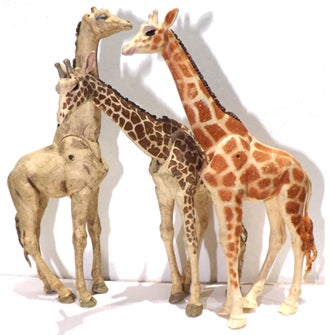
At left, my rather worn original 1972 giraffe, with two other versions of the same model: the darker version has the 1980 livery. Credit: Darren Naish
Britains toys have some significant personal meaning to me: various of them (namely the 1965 African elephant and 1972 giraffe) are among the first toys I ever owned, I have fond memories of my dad bringing Britains toys home to me after his day at work, and I have tremendous nostalgia attached to the shops and – more specifically – the now long-gone glass-fronted display cabinets associated with the sale of these toys. Britains still exists, and it isn’t difficult to find its products (mostly farm vehicles) in toy shops even today. The ‘wild’ or ‘zoo’ animals that I’ll mostly be talking about here are, however, no longer on sale except as pre-owned items.
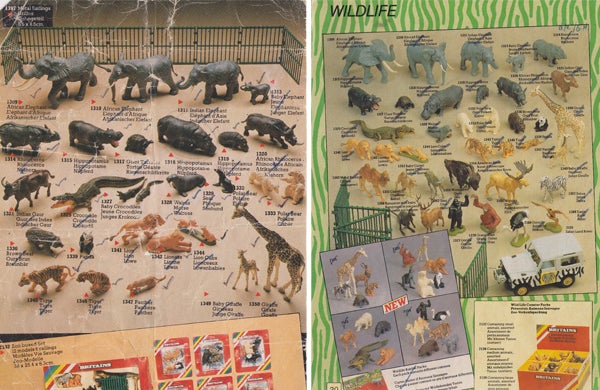
Catalogues that featured all models on sale were available, free, from toyshops. Here are the zoo animal pages from - at left - a pre-1988 volume and - at right - the 1988 one. Credit: Darren Naish
Thanks to an absurd if not embarrassing amount of effort, I own today a huge collection of Britains animals. A few good books discuss the history and construction of the models, and in particular I’ve relied on Peter Cole’s very thorough Suspended Animation: An Unauthorised History of Herald & Britains Plastic Figures (Cole 2004).

Covers and pages of catalogues (I wish I’d retained more of them); the cover of Cole’s excellent book at upper right. Credit: Darren Naish
A quick history of Britains. ‘Britains’, if you’re wondering, is not so named because of its association with the UK, but because of William Britain, founder of the company. It is in fact wrong to speak of the range of toys concerned as if it begins and ends with Britains, however: prior to a merger that happened in 1959 (and was instigated by William Britain’s grandson, Dennis Britain), what was effectively the same company was known as Herald Miniatures. This itself was known beforehand as Zang – a company that got going in 1946 and is named for Polish engraver and metal dealer Myer Zang – before 1955. The full history of these companies is of course far more complex; see Cole (2004) for much more. Zang, Herald and Britains were all very much London-based but production switched to Hong Kong in 1965, the words ‘made in Hong Kong’ being indelibly stamped into my childhood memories as it was in so much moulded plastic.
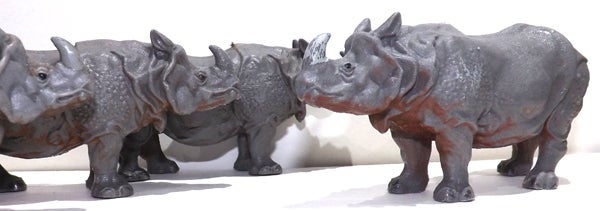
Oh my god -- how good is the Britains 1961 one-horned rhino? When pristine, it has a brown underside and grey paint on its shoulders, rump and horn. Credit: Darren Naish
Britains’ zoo and farm animals have to be seen as spinoffs, essentially, of a range of soldiers that began construction in 1953 and included horses right from the start. These plastic models were not de novo themselves, but evolved from metal ancestors that had been in production since 1929 (and which had also involved zoo animals right from the start). In this article I will very much avoid the long and complex story associated with injection moulding technology and the materials used in creating plastic models (Cole 2004); suffice to say that plastics of various forms (polythene and PVC in particular) allow for higher fidelity and more detail than metal, as well as improved durability and thus greater playability.
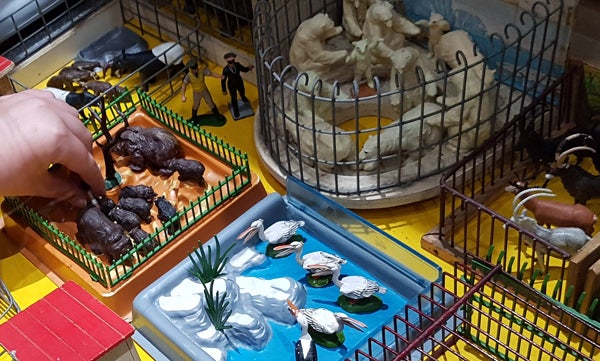
Britains models have a huge degree of what’s known as playability. Look for the anteaters, tapirs, pelicans, sable antelopes and many, many bears in this crowded zoo scene. The hand belongs to my daughter. Credit: Darren Naish
Zoo animals emerge. Anyway, the farm animals associated with Britains originated as Herald pieces in 1955. They included cattle, pigs, geese, ducks and chickens, a selection joined by sheep, foals, turkeys, dogs, goats and rabbits in 1961. This range would expand further, and eventually involve whole moulded farmyard playsets. More importantly for the story here, a range of plastic zoo animals emerged in 1960: bears, lions, tigers, a ‘panther’ (it seems to be a small leopard), kangaroos, an ostrich, baby rhino, pelican, penguin, sable antelope, springbok and wolf. It’s been said that some of these pieces are rather static and less realistic than the farm animals. This might be down to the skills of the specific model-makers, it might be became some of the pieces were copies of their crude metal ancestors, or it might be because they were effectively created freehand without appropriate research on the animals themselves. Certainly some of them look more like imagined versions of animals than the real things.
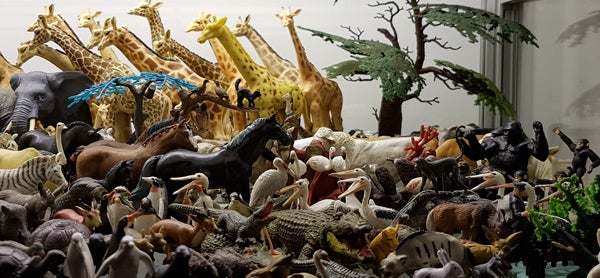
This image gives you some idea of the diversity of animal toys (with a few plants too) offered by Britains over the years... though there are a few Starlux figures in the lower right part of this image. Credit: Darren Naish
Having said that, one thing I’ve always wanted to do is track down the inspirations for the specific models, since I think that at least a few of them are based on photos of given individuals. The one-horned rhino of 1961, I’ve always thought, was based on a famous rhino that lived at London Zoo, but I can’t confirm this. In fact there’s hardly any information out there on what the model-makers were looking at during the design stage, and I think that (as noted above) they were sometimes creating the models freehand, or at least after sketching the animal and coming up with a design that worked. A 1965 photo shows model-maker George Ford sculpting a model (of an African elephant) from life – the elephant is in what seems to be London Zoo. The elephant he’s sculpting is surely the prototype of the iconic model elephant Britains released in 1965, a very smooth-skinned but highly popular piece that was still in production in 1999.
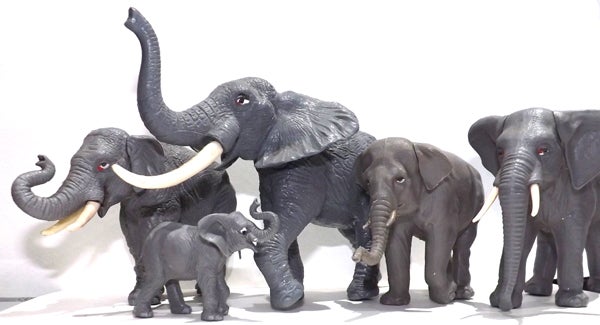
The Britains elephants. The oldest is the Asian elephant on the right, released in 1961. The big 1981 African bush elephant - the one with trunk raised high - is missing its right tusk. Credit: Darren Naish
Anyway… fast forward to the late 1980s (my most formative years) and toyshops the length and breadth of the land were offering a range of 35 zoo animals, all relatively familiar as animals go. Various more obscure animals had come and gone by this time. Some of these are relatively rare and sought after today, including the platypus, eland, black panther and warthog. A baboon, several baby bears, baby crocodiles, a set of chimpanzees (designed to be sat on chairs for a ‘tea party’), penguins, a giant anteater and others came and went during the 60s and 70s.
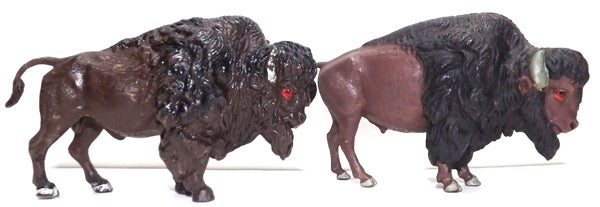
Original bison at left, 1980 bison at right. They both have their charm but one looks more like a furious hellbeast than the other. Credit: Darren Naish
Many of the figures underwent a change over the years, more recent versions being made of different plastics or being quite different in look and proportions. Compare the two American bison shown here: one came into being in 1961, the other in 1980. The Malayan tapir can be found in several versions: over time, it became stockier, bigger and altogether more realistic… though none of this saved it from deletion in 1985. Indeed a number of models were phased out and deleted, perhaps because they weren’t especially popular. In addition to those listed above were the flamingo, stork, wild boar, okapi and griffon vulture. Meanwhile, the lions, polar bears, zebras, gorillas, giant tortoises, kangaroos, sea lions and walruses, among others, saw replacement by improved versions.

Many Britains animals were re-released repeatedly, their proportions and colour schemes changing over the years. The ‘panther’ - surely a leopard - was only released as a black version once, and its spots changed from fuzzy stensil efforts to sharp markings in 1980. Credit: Darren Naish
Anyway, there are several reasons for the changes observed in those models that were kept in production. Manufacture switched to China in 1991 for economic reasons, and post-1991 models thus have a somewhat different look (they are shinier and slightly translucent) but more elaborate, finer colour schemes. Also of note is that, by the late 1960s, the older plastic moulds had begun to deteriorate, meaning that replacement was unavoidable (Cole 2004).

Tiger transformation. Finer, slimmer proportions and finer markings emerge as we get closer to the present. The stocky version at far left is from 1960, the fine-marked one at far right from the late 1980s. Credit: Darren Naish
‘Multi-part models’: of separate bases, mobile necks and jaws, antlers, tusks and elephant ears. Improvements in moulding techniques and knowhow also resulted in changes. Starting in 1956, Herald had begun to produce horses that plugged into a separate moulded base (a small replica of the imagined environment), this meaning that dynamic poses could be adopted by pieces that could never stand unassisted. Several zoo animals produced from 1961 onwards also had separate bases, namely a baby giraffe, baboon, flamingo, stork, and a standing (and bizarrely proportioned) baby bear (originally a brown bear, later changed to a polar bear).
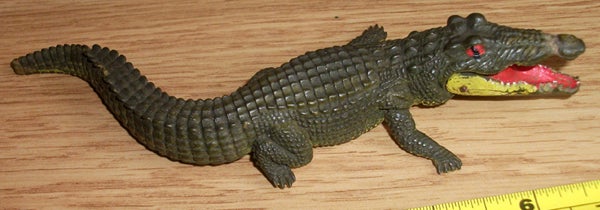
The 1972 crocodile with mobile jaw, surely one of the greatest plastic toys of all time. If you’re interested in crocodylians it’s your duty to obtain one of these. Credit: Darren Naish
The 1961 adult giraffe was replaced in 1972 by a version with a mobile neck, ditto for an ostrich which replaced a smaller, static figure of 1960; an adult crocodile with a mobile lower jaw was also introduced in 1972 and replaced the crude 1961 version without that feature. Then there are the several elephants where the ears, and later the tusks and the entire head, were created as separate components that could be slotted on or bolted together via the use of plastic plugs and sockets, no metal pins being required. A red deer stag with detachable antlers saw production in 1971 – a huge improvement on the crude deer that had been available since 1960. A moose with detachable antlers was introduced later, in 1977.

A toy company that makes Red deer, Malayan tapir, Gaur, Sable antelope, Moose, Brindled wildebeest, Okapi and so many others... I first learnt of many of these animals because of these toys. The Okapi has a horrible tendency to lose its protruding tongue. Credit: Darren Naish
The ultimate of these ‘multi-part’ models is the big bull African bush elephant produced in 1981. This excellent model, which is about 20 cm long, now fetches a fairly high price. I’m after a new one, since the tusks are broken on both pieces I own.
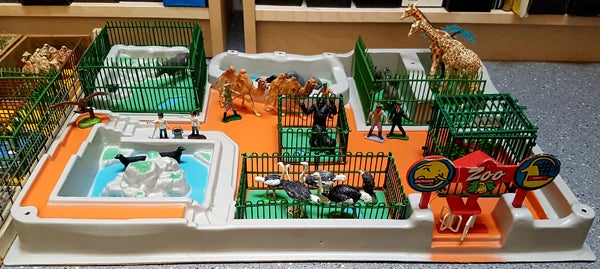
Britains made zoo playsets as well - this one is from the 1960s or 70s and is missing a few bits. A few of the pieces shown here (like the metal caging at right) do not belong with the zoo. Credit: Darren Naish
Zoo and farm sets and accessories. Finally, note that Britains didn’t just make toy animals, but accessories too, in particular zoos, cages, replica plants and so on. Their models trees are among the best model trees ever produced; I could say a lot about them but would spin off at radical tangent if I did. Several zoo sets were produced from the 1960s onwards and involved rock pits, pools for penguins and pelicans and so on.
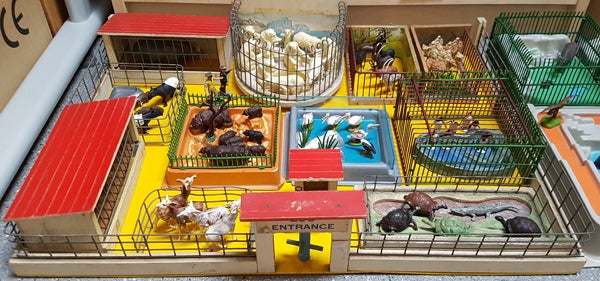
The Elf wooden zoo of the 1960s, though with a few additions from later years. It’s a little crowded. Credit: Darren Naish
A short-lived range of ‘minisets’ were produced in 1968 and consisted of a sort of diorama that the owner produced through assembly; several featured zoo animals, but they were at a smaller scale than the other Britains toys and thus never that liked or successful. A wooden zoo set was produced during the 1960s: I understand that it was made by a company called Elf, not by Britains, but it was clearly designed to accommodate Britains animals. If you have all the enclosures in place you sure end up with a very crowded, inhumane menagerie, but it’s actually not a bad reproduction of some of the more horrendous British zoos of previous decades.

The 1968 crocodile-themed miniset, featuring crocodiles that (in 1971) were released as stand-alone figures. The stand-alone figures lack the holes in their bellies that the miniset versions possess. Credit: Darren Naish
A plastic moulded zoo set was produced by Britains sometime later and was in production for several years. It’s not bad at all (today being sold at a fairly high price), though good luck getting hold of one that has all the flags and other small accessories. Several farm sets were also produced from the 1970s onwards, the best of which (available until 1988) features a pond and stream, separate walled enclosures, a tree and an area of sculpted substrate marked with animal footprints and vehicle trackmarks. All of these larger sets are about 60 cm x 45 cm, so require a large area of clear floorspace.
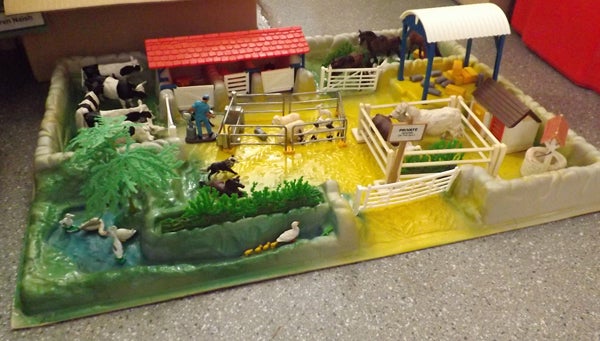
I’m a huge fan of the farm playsets produced during the 1980s. This one is brilliant: so many great details. The henhouse and well at far right do not belong. Credit: Darren Naish
Competitors, replacements and the end of an era. No other company ever really did what Britains did – that is, produce such a range of animals at a size that, for whatever reason, has such a high degree of ‘playability’. Model animals today (those by, among others, Schleich, Papo and CollectA) are built at a somewhat larger scale and don’t have quite the same appeal as miniatures, though I’m sure I say this based mostly on biased nostalgia. I should also say that the French company Starlux went down the ‘Britains road’, producing a huge range of wild animals (and extinct ones too) that included such obscure creatures as yaks, otters, beavers, pythons and Phorusrhacos, the great crippling issue being that their models were made of an incredibly brittle, shiny plastic unable to withstand the gentlest of collisions. I have many Starlux models and have always disliked them for this reason. I cannot imagine a child building up and maintaining a collection.
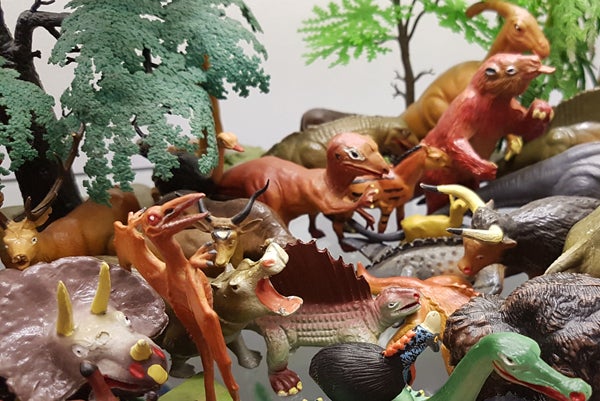
A selection of Starlux toys, including both prehistoric animals and modern ones (though with Britains trees and a few other things creeping into shot). They’re great, but they’re so, so annoyingly brittle. Credit: Darren Naish
I actually wrote to Britains more than once during the 1980s, suggesting that a range of new animal toys were needed. I can’t find the response letters I received (they were signed ‘The Captain’), but I recall being told that while they couldn’t make all the new models I suggested, they were going to make some of them. My suggestions (each accompanied with a colour illustration) include eagle owl, thylacine and python. There were others but I’ve forgotten. Alas, the models were not made, so far as I know.
And, today, Britains zoo animals are no more, production having ceased in 1999. A small selection of farm animals are still made, but the manufacture of replica animals is now otherwise occupied by companies that have a very different style.
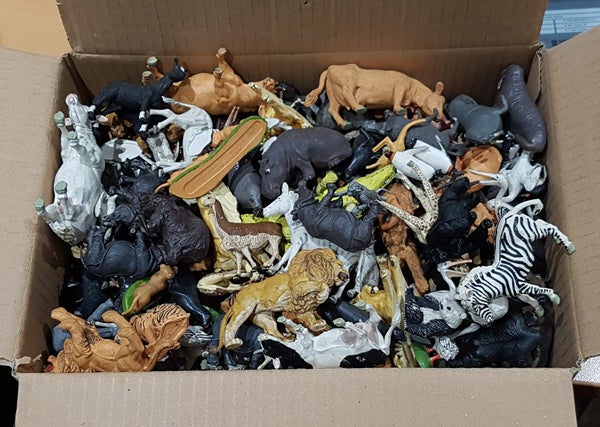
Britains animal toys are almost gone. But long live Britains animal toys. Credit: Darren Naish
Refs - -
Cole, P. 2004. Suspended Animation: An Unauthorised History of Herald & Britains Plastic Figures. Plastic Warrior.